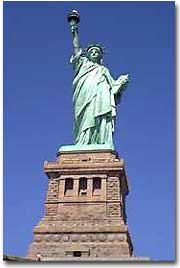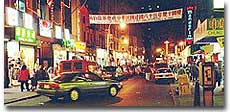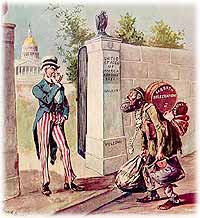38c. The Rush of Immigrants

The Statue of Liberty — a gift from France upon the United States' 100th anniversary — welcomed immigrants from around the world to New York City.
Immigration was nothing new to America. Except for Native Americans, all United States citizens can claim some immigrant experience, whether during prosperity or despair, brought by force or by choice. However, immigration to the United States reached its peak from 1880-1920. The so-called "old immigration" brought thousands of Irish and German people to the New World.
This time, although those groups would continue to come, even greater ethnic diversity would grace America's populace. Many would come from Southern and Eastern Europe, and some would come from as far away as Asia. New complexions, new languages, and new religions confronted the already diverse American mosaic.
The New Immigrants

Almost every city in America is home to a Chinatown. This street scene is from New York City's Chinatown — one of the biggest and best-known.
Most immigrant groups that had formerly come to America by choice seemed distinct, but in fact had many similarities. Most had come from Northern and Western Europe. Most had some experience with representative democracy. With the exception of the Irish, most were Protestant. Many were literate, and some possessed a fair degree of wealth.
The new groups arriving by the boatload in the Gilded Age were characterized by few of these traits. Their nationalities included Greek, Italian, Polish, Slovak, Serb, Russian, Croat, and others. Until cut off by federal decree, Japanese and Chinese settlers relocated to the American West Coast. None of these groups were predominantly Protestant.
The vast majority were Roman Catholic or Eastern Orthodox. However, due to increased persecution of Jews in Eastern Europe, many Jewish immigrants sought freedom from torment. Very few newcomers spoke any English, and large numbers were illiterate in their native tongues. None of these groups hailed from democratic regimes. The American form of government was as foreign as its culture.
The new American cities became the destination of many of the most destitute. Once the trend was established, letters from America from friends and family beckoned new immigrants to ethnic enclaves such as Chinatown, Greektown, or Little Italy. This led to an urban ethnic patchwork, with little integration. The dumbbell tenement and all of its woes became the reality for most newcomers until enough could be saved for an upward move.
Despite the horrors of tenement housing and factory work, many agreed that the wages they could earn and the food they could eat surpassed their former realities. Still, as many as 25% of the European immigrants of this time never intended to become American citizens. These so-called "birds of passage" simply earned enough income to send to their families and returned to their former lives.
Resistance to Immigration

Political cartoons sometimes played on Americans' fears of immigrants. This one, which appeared in a 1896 edition of the Ram's Horn, depicts an immigrant carrying his baggage of poverty, disease, anarchy and sabbath desecration, approaching Uncle Sam.
Not all Americans welcomed the new immigrants with open arms. While factory owners greeted the rush of cheap labor with zeal, laborers often treated their new competition with hostility. Many religious leaders were awestruck at the increase of non-Protestant believers. Racial purists feared the genetic outcome of the eventual pooling of these new bloods.
Gradually, these "nativists" lobbied successfully to restrict the flow of immigration. In 1882, Congress passed the Chinese Exclusion Act, barring this ethnic group in its entirety. Twenty-five years later, Japanese immigration was restricted by executive agreement. These two Asian groups were the only ethnicities to be completely excluded from America.
Criminals, contract workers, the mentally ill, anarchists, and alcoholics were among groups to be gradually barred from entry by Congress. In 1917, Congress required the passing of a literacy test to gain admission. Finally, in 1924, the door was shut to millions by placing an absolute cap on new immigrants based on ethnicity. That cap was based on the United States population of 1890 and was therefore designed to favor the previous immigrant groups.
But millions had already come. During the age when the Statue of Liberty beckoned the world's "huddled masses yearning to breathe free," American diversity mushroomed. Each brought pieces of an old culture and made contributions to a new one. Although many former Europeans swore to their deaths to maintain their old ways of life, their children did not agree. Most enjoyed a higher standard of living than their parents, learned English easily, and sought American lifestyles. At least to that extent, America was a melting pot.






